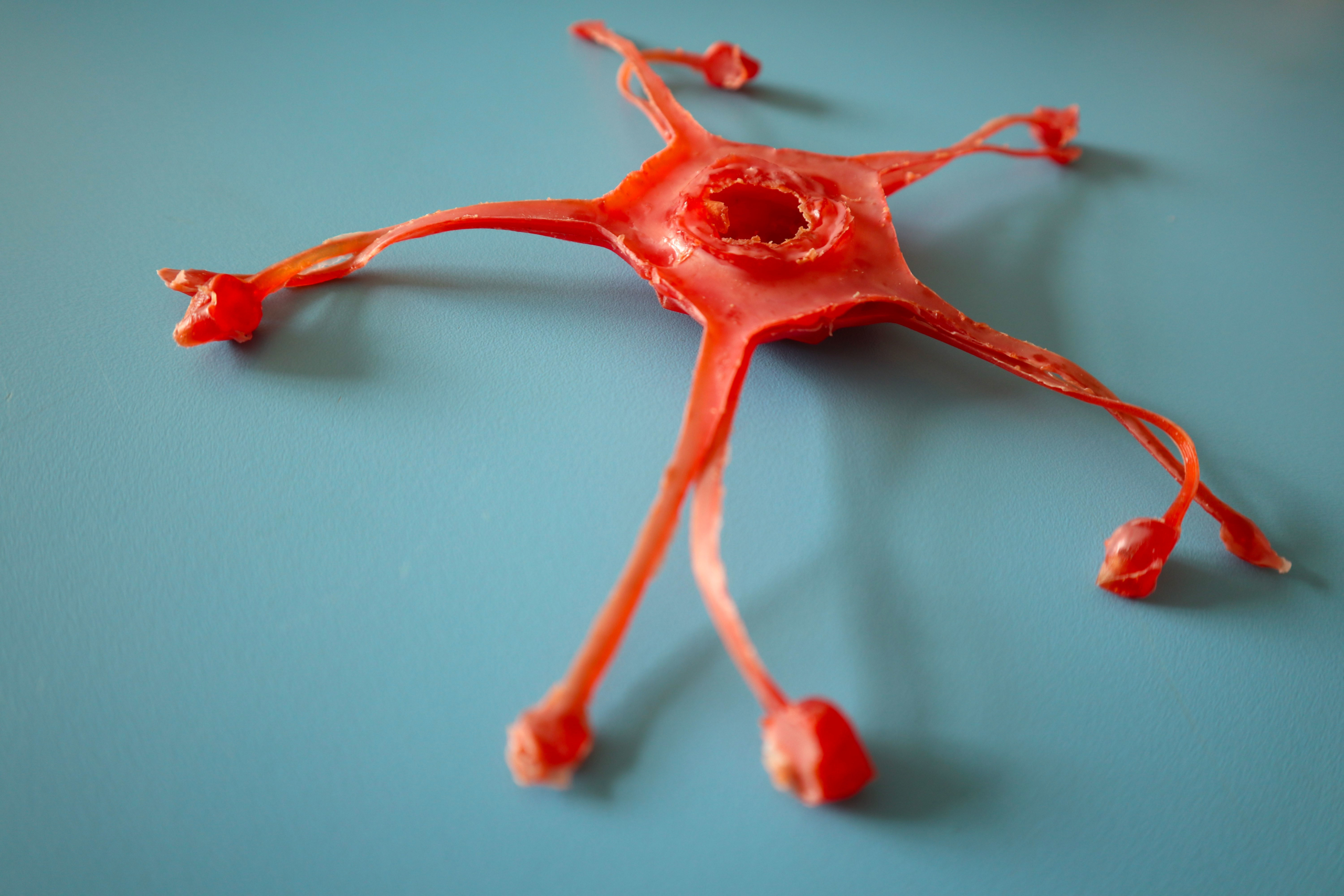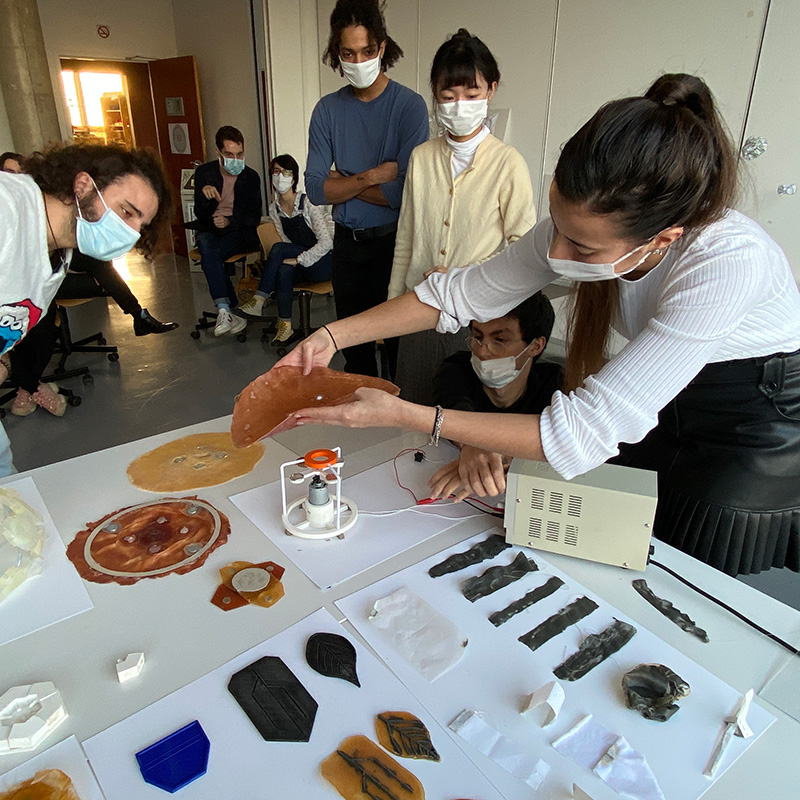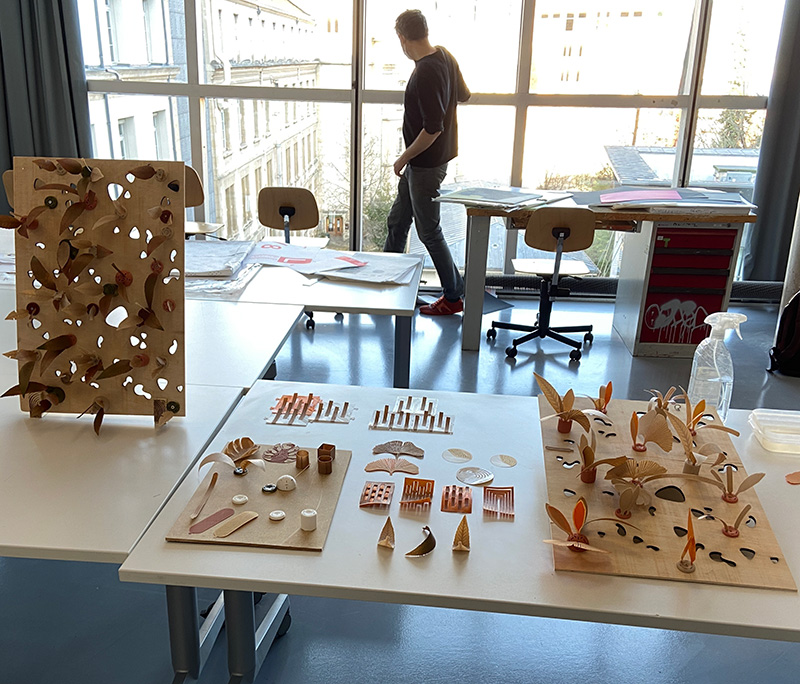Training through practice
The educational method of La Chaire Arts & Sciences is that of research-creation via collective scientific projects (at Polytechnique) and research-creation modules (at EnsAD) that are part of the student curriculum.
These workshops combine theory and practice and are based on themes initiated by La Chaire Arts & Sciences. They allow students to experiment with learning by doing, by creating prototypes or artistic installations that encourage multidisciplinary cooperation.
Collective scientific projects in the arts & sciences | École Polytechnique
Collective scientific projects are incorporated into the student curriculum. They are offered as part of the arts & sciences program of the École Polytechnique LadHyX. The aim is to create an artistic installation based on a scientific phenomenon.
The students follow collective scientific projects in arts & sciences (one day per week over six months, in groups of four to six 1st- or 2nd-year students) or a Humanities and Social Sciences “MODAL” (applied module in a laboratory) whose methodology includes study of the state of the art in the history of sciences, social sciences (literature, history, geography, and art history); analysis of the scientific phenomenon; and design and development of an installation.
20201ff2021 academic year
Vaisseau climatique (Climate Vessel)
Teaching team: Aniara Rodado and Jean-Marc Chomaz
Students: Yohan Boulard, Aude Champouillon, Jennifer Han, Matthias Molénat, Adèle Petiteau, Axel Tassigny
The project seeks to create a “climate vessel”—an artistic installation that recreates various climates inside a room using machines whose energy costs as little as possible. The objective is to allow a spectator to experience a space-time journey by varying, for example, the temperature or the humidity level of the place.
This collective project requires students to identify the relevant parameters and understand climate mechanisms, with the goal of creating machines that can reproduce the desired conditions.
Keywords: climate change, atmosphere, ecology
Eclipses
Teaching team: Jean-Marc Chomaz and Didier Bouchon
Four students
Scientific, aesthetic, and symbolic research and reflection on eclipses and their meaning in the history of science and in literature. Study includes how they are perceived by different peoples (history) and how they are interpreted cosmologically/theologically (history of religions), with the goal of developing two projects of perception of an eclipse.
Keywords: turbulence phenomena, stratification of the optical atmosphere and quantum mechanics, climate change, social science research
20191ff2020 academic year
Shadow of a Flame : flammes chantantes (singing flames)
Teacher: Jean-Marc Chomaz
Students: Pierre Cussenot, Sébastien Legrand, Augustin Patey, Kévin Tocaben
Creation of an artistic system based on “singing flames,” a phenomenon of thermo-acoustic instability discovered in the 19th century: when a flame is introduced into a tube at a certain level, it emits a sound and begins to oscillate. Based on this phenomenon and after studying the literature on it and by exploring the symbolism of the flame, the students wished to “create a dialogue between two singing flames in the middle of an optical installation.”
20181ff2019 academic year
Climax
Teaching team: Jean-Marc Chomaz and Laurent Karst (LABOFACTORY)
Climax is an immersive system of luminous clepsydras, each one associated with a particular city or region of the planet where time flows drop by drop, to the rhythm of the rain of the future, while concentric waves leave the edge of the basins and move toward the center, going back in time according to the level of rainfall of the place.
Climax helps evokes the “anthropopause,” a period of transition to a new era, when geological time collides with human time.
20171ff2018 academic year
Miroir noir (Black mirror)
Teaching team: Jean-Marc Chomaz and Laurent Karst, plus members of LABOFACTORY
Humanities and Social Sciences MODAL – Student: Diane Lenormand
Goal: explore the concept of “black body” in order to seize the concept by creating a human-scale installation that can be exhibited as an artistic system, and write a follow-up report.
This work led to the creation of an installation made up of small black boxes, whose dark interior is heated to different temperatures: when approaching the front opening, the observer cannot see anything with their eyes but must perceive the presence facing them in a different way.
Sky
Team: LABOFACTORY (Jean-Marc Chomaz, Laurent Karst, Filippo Fabbri, Greg Louis) in collaboration with researchers from the LMD and SIRTA (Imma Bastida), Antoine Garcia (Ladhyx) assisted by the students Coralie Betbeder (École Polytechnique) and Eunyoug Lee (ENSA Dijon).
In a 2.5-m basin arranged on three tables, a layer of mist is animated by mobile, ephemeral, ghostly, and mucilaginous forms. This substance is of uncertain materiality. It changes texture and moves in response to movements around the basin, reacting to the distant caress of a hand. The space that this behavior creates in the imagination is musical rather than choreographic, as the mist behaves as a sound material made of textures and rhythms. In “Sky,” human interaction affects the mist in the same way that, in the real world, it affects climate change.
Research-creation modules | École des Arts Décoratifs
The research-creation modules (RCMs) combine theory and practice on a theme linked to La Chaire Arts & Sciences. They offer participants a space for reflection and experimentation, supervised by artists and researchers from EnsadLab’s Reflective Interaction group.
The RCMs are included in the curriculum of 3rd- to 5th-year students at EnsAD. They are held one day per month over a trimester and end with an intensive week of presentation. Each module includes around 30 students.
Behavioral Objects
Teaching team: Raphaëlle Kerbrat, Olivain Porry, Filipe Pais, and Didier Bouchon
This RCM has students explore the notion of behavioral objects by using the prototyping tool “MisB KIT,” a modular robotics kit developed by the Reflective Interaction group (EnsadLab) to create and experiment with behavioral objects. The students can familiarize themselves with robotics by exploring the notions of interaction and collective expressiveness, while at the same time incorporating this reflection into their own creative process. With this module, students are encouraged to sharpen their critical sense with regard to information technologies, thereby helping them to invent innovative creative conditions.
Keywords: Modular robotics, networked objects, IoT, motion expressiveness
3D/4D printing
Teaching team: Antoine Desjardins and Giancarlo Rizza, with the participation of Benoît Roman and Brice Ammar Khodja
The objective of this experimental RCM is the synthesis, printing, and handling of materials in activatable and controllable forms, so that they can be used in spatial and environmental systems designed to influence the behavior of their forms.
This proposal came about following the encounter between the artistic work of Antoine Desjardins (who researches natural forms and formal and material combinations enabling them to appear), and the work of the physicist Giancarlo Rizza (who researches how to set materials into motion using magnetized nanoparticles). Smart materials, also called “functional materials,” can be sensitive, scalable, and adaptive. 4D printing uses these properties to program the actions of a 3D-printed object in response to changes in the environment.
Keywords: Materials, active environment, 4D, modeling, 3D printing
Les formes du web (The forms of the web)
Teaching team: Lucile Haute and Julie Blanc
Collective workshop to make the web browser a portal for the creation of graphic and interactive objects for designers and artists. By offering an initiation into some web languages, both standard and open source (HTML, CSS, JavaScript), this workshop enables students to explore the creative possibilities of the web through notions associated with digital culture to develop a free technical culture of design and art. These notions include responsive web, digital liquidity, variable fonts, scripts, interactive animations, and parametric design.
Each session is devoted to the exploration of a graphic and/or interactive notion linked to web technologies, sometimes with a guest. Later, a week of workshops makes it possible to learn how to use web technologies step by step, to take possession them, to highjack them, and to play with them.
Keywords : interaction, design, code (html, css), free tools











